Your daily dose of Product Management Goodness
Want to know more?
We would love to hear your questions and suggestions for topics you would like to see covered in our future blog posts, so don't be shy and get in touch!


Delivering value vs pain points
Delivering value vs addressing pain points
Sometimes the point of difference you have over a competitor has nothing to do with the product and all to do with an adjacent pain point you can address. Simple example, two companies supply house bricks to the construction industry. Their bricks are identical in every way. Which would the house builder choose? Conventional logic says “the cheapest” and both businesses would engage in a price war. But step away from the product and think about the bigger picture. House builders can have a real pain point around cash-flow – address that and you unlock a point of difference. Charging more per brick, but having payment terms that mean the house builder doesn’t pay until the property is sold is a potentially disruptive strategy
Even for Product Managers, it’s not always about the product.
read more

Disinter-mediation
Disinter-mediation is driving change
There’s a theme amongst many of our customers at the moment – when they look forward 5 years they see a radically different market as technology reduces the need for intermediaries between producers and consumers. This can be seen in many sectors; banking (p2p), legal (e-conveyancing) , finance (robotic accounting). Known generally as disinter-mediation, this trend generates risk and opportunity for Product Managers. But how should we react? The key is to understand who your customers are today and who they will be tomorrow – disinter-mediation does not necessarily remove the market need, but it can change the economic buyer. If your product is aimed at an intermediary its worth thinking about how disinter-mediation will impact your offer and how you need to change to appeal to those adjacent in the value chain.
read more
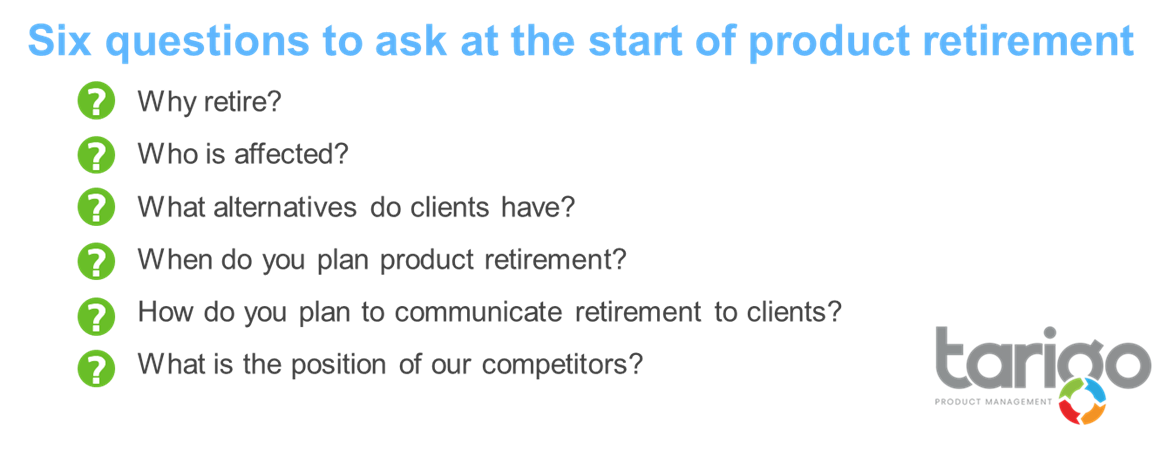
How should you retire a product?
Before starting a product retirement we use these six questions to check if retirement is something that should be considered – a set of basic checks to clarify why you’re retiring a product and what it will mean to you, your customers and your competition.
read more

PM health check
How do you review the maturity of a PM function? We use a 360 review:
• People
Without the right team in place it’s impossible to excel. We review the team through capability (Do they have the potential to be a great PM?), skills (Do they have the right PM experience?) and scale (Is there enough of them?)
• Processes
We review the full process, reporting, RACI, etc, viewing the process in terms of fit to your business (Risk vs reward vs scale vs speed vs certainty vs evidence vs innovation)
• Tools
Without standardisation, product managers use such a wide variety of tools that it becomes increasingly difficult for a management team to make reasoned decisions – they cannot do an ‘apples to apples’ comparison. We review the complete process suite for robustness, ease of use, visibility and adherence.
• Environment
A great PM team, with the right processes, tools and templates can still fail to thrive because of the environment - stakeholders, supporting processes and management not aligning with product. We review stakeholder teams leadership engagement and adjacent processes to asses alignment.
read more

Managing feature parity
Three customers I’m working with at the moment all have the same core issue; they’re going through a platform rewrite and are struggling with feature parity – thinking that the new product should offer EVERYTHING that the old product offered and more on day one. The start point is often bad customer- communication “Of course the new platform will deliver everything that the old one did” followed by blind panic at the realisation that feature parity will take years. Here are our tips for dealing with this:
• Find your new platform USP and make that the narrative – perhaps better security, speed, data. Something the old platform doesn’t do has to be the focus
• Make the list and prioritise – there’s nearly always an 80/20 rule, so list every feature and find the 20% that customers really use to help define the MVP. Hard research required
• Find you initial sector – Don’t attempt a big bang release – find that sector who see most benefit around your new USP and who match your MVP
• Build from there – It took years to build your current platform. It will take time to build the new one.
read more

Aligning with the sales team
What do your sales team sell? Might sound a weird question and many Product Managers would respond with “They sell my products!” .But in truth some sales teams don’t sell product, they sell capability. Think of it like this; if the sales team hasn’t traditionally been well-served with great go-to-market messaging and collateral about the product set then they tend to develop a habit of selling capability – an approach where they say “You tell me what you want and we will get it built”. The most obvious symptom of this is that every customer has special requirements that load development and reduce product profitability. From a Product Manager perspective the best response is to get in front of your sales team, deliver great go-to-market content and make sure they are ready, willing and able to sell the product you’ve built. From a business perspective it’s worth thinking about how sales teams are rewarded – getting a bigger commission cheque for selling off-the-shelf vs could be the right incentive.
read more

Automation
Meet my new travel buddy. Not sure of his name, but he works in the hotel I’m staying in and can deliver things to my room. A gimmick or the start of a revolution?
In product management we often think of mega trends and the impact those trends will have on our market. My robot buddy fits into the trend of ‘automation’. This trend could drive huge change from autonomous vehicles through to robotic accounting. How impactful will automation be? We don’t know, but as product managers we better have a plan. The risk of no plan? Ask Kodak about digital photography or blockbuster about online movie delivery and see the risks of ignoring trends.
read more
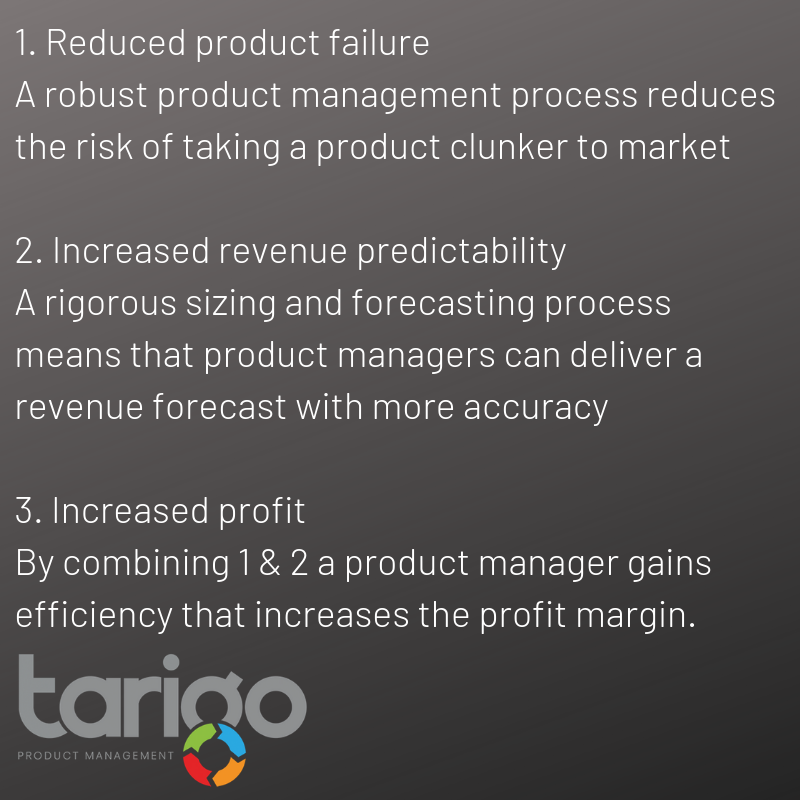
Measuring Product Managers
How do you measure product managers?
It’s a regular question - how should I assess a product manager? My view is a simple one - don’t assess what they do, assess what they help the business achieve. There are three things that an effective product manager can help a business achieve:
These are valuable to the business and define the value of product management to the organisation
read more

Marginal gain in action
Marginal gain in the Product Management world is about sweating the small stuff - taking care of the details that might just get you ahead of the competition. Here’s my real-world example. I landed in Shanghai yesterday, got to my hotel and found my laptop power supply not working. In a bit of a panic (I’ve got three days of presentation ahead of me) I went down to the hotel lobby for help. They checked if any were in lost property, and when that didn’t work they actually took me to a local store, dealt with the translation and, much to my relief, got me a temporary fix that will get me through the next few days. So how does this translate into marginal gain? Well next time I’m booking a hotel, this very positive experience of the Crowne Plaza will stay with me and make me more likely to book with them. Marginal gain works in aggregate – taking care of small stuff really does add up and make a difference.
Good job Cowne Plaza Shangai Xiayang Lake!
read more

What’s in a name?
Here is England the new royal baby has just been named - Archie Harrison Mountbatten-Windsor. For Archie it’s less important, but for most of us our name gives all sorts of clues as to who we are, where we came from, our gender, our age, etc. The same’s true with product naming. What we call our product, service or business can have significant impact on its success and position (Think Easyjet and you have a business name that can’t be exclusive and high-end). Then there are local language issues (Think Mitsubishi Pajero in South America), search engine optimisation problems, (call it something so common it will be on page 5 of the search results or so complex and no-one will be able to spell it), etc. Here’s our checklist of things to think about when you name a product
read more

Customer Research
Making sense of customer research
So you’re conducting some customer research in the b2b world, trying to figure out if that new product idea is something your customers will buy and use. But how can you tell? You present your slide deck and they seem positive – but does that mean they will buy? This is a typical product management issue – trying to interpret customer reaction and turn it in to a revenue forecast. Here’s a simple tip. When you present your new idea hold three pieces of information back:
1. The price
2. The delivery date
3. Some integration details
Customers with real interest will ask questions like “When can I have it?”, “How much is it?” or “Will it work with our back office processes?”. Customers who don’t ask are probably not interested.
read more
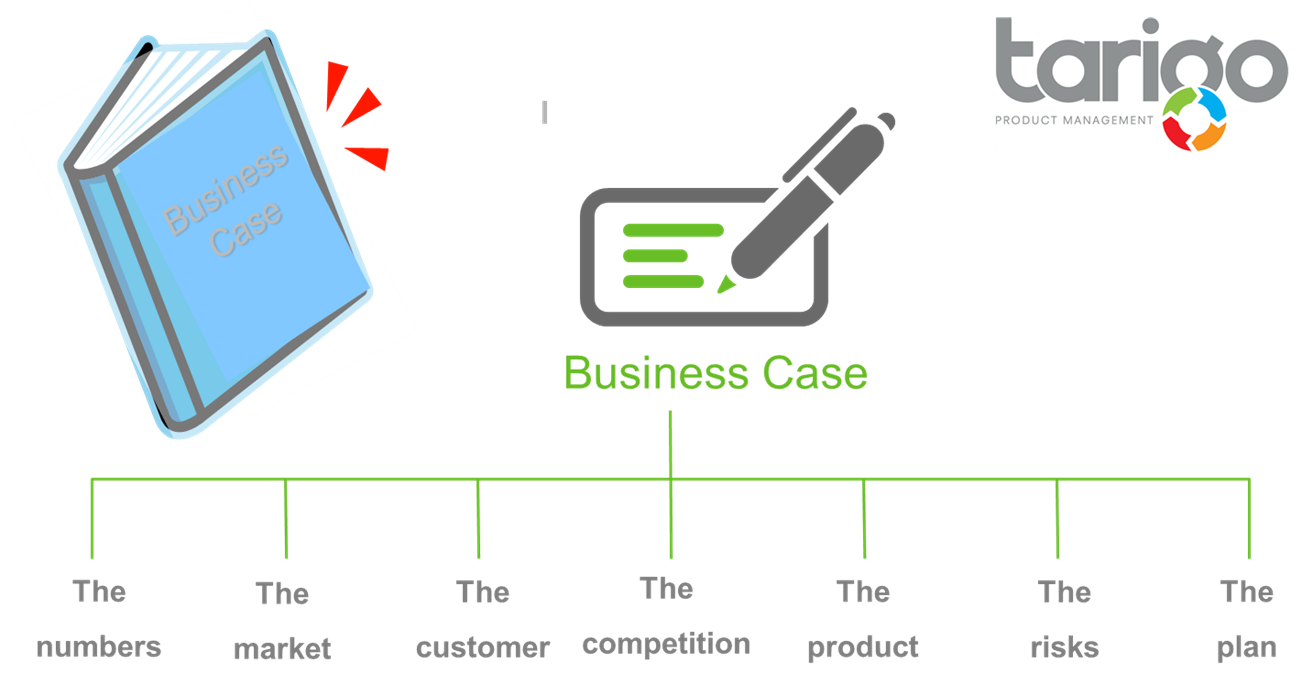
Building a business case
Building the business case is like doing a maths exam
“Build a business case”. A request many product managers hear when looking for funding for a new product or enhancement. But what do we mean by business case? Many take it to be some financials – a set of numbers to validate that by spending X we’ll gain Y (and hopefully Y is bigger than X!). But the financials are really just the business case summary. The rest of the document tells the full story – why we should build, what our market looks like, etc. It builds the narrative that makes the numbers believable. Think of it like that maths exam you did at school, 1 point for the answer and 9 points for the method that got you there.
read more
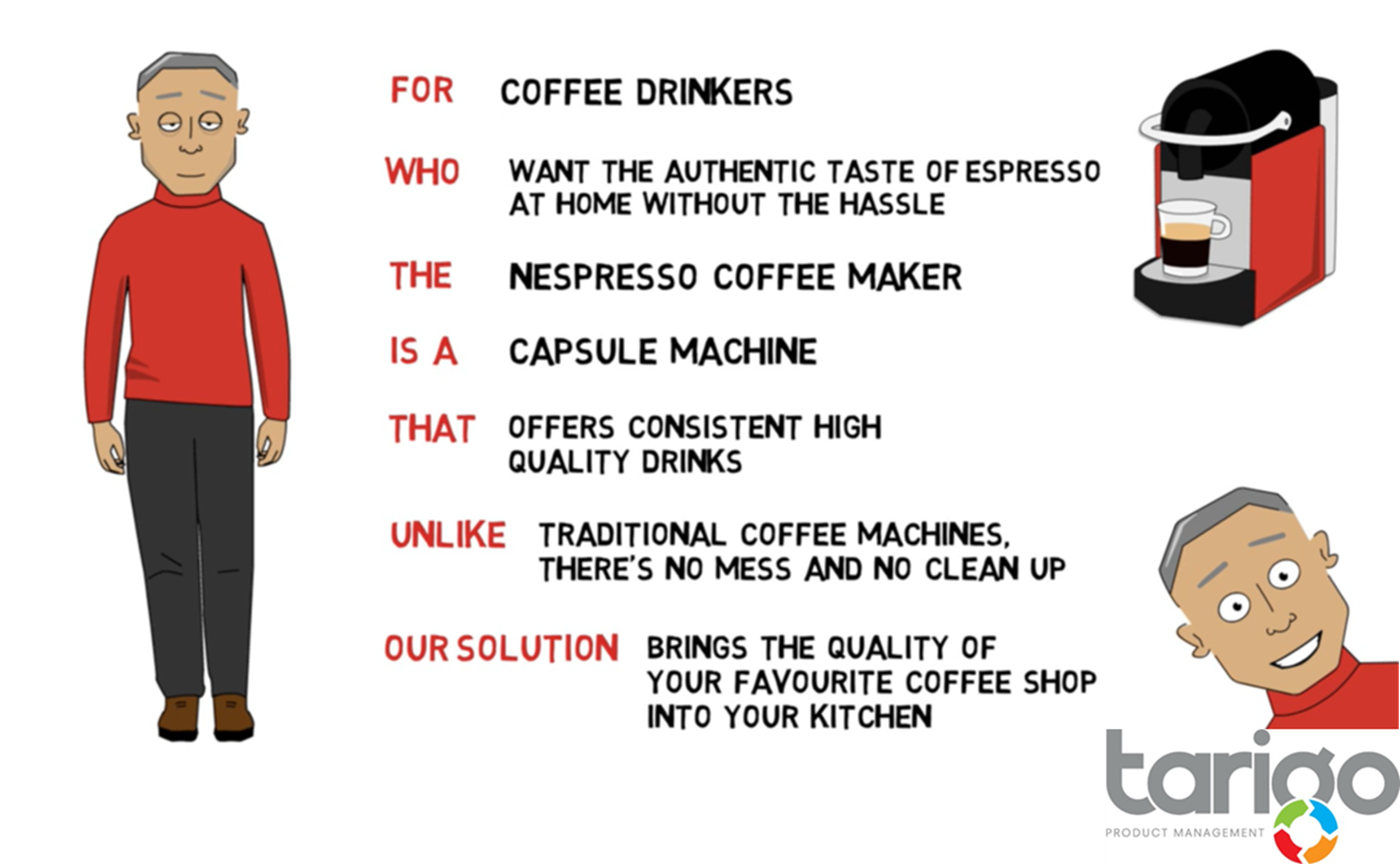
Four Tips
Four tips for building outstanding Value Propositions
Building a really compelling value proposition is central to great Product Management – a great product needs great messaging to thrive in a market.
So how do we do it? The start point is to use a framework like the one in the image below, complete it, and then review it with these four simple rules:
1. Does it clearly identify a targetable market?
Know who you’re aiming at
2. Does it define a real and substantial need in that market?
Fix a problem they want you to fix
3. Is there clarity in the proposition and the value it delivers?
The market needs to understand what you’re trying to sell to them and why
4. Is there a defensible point of difference?
The market need to know why they should choose your product.
read more
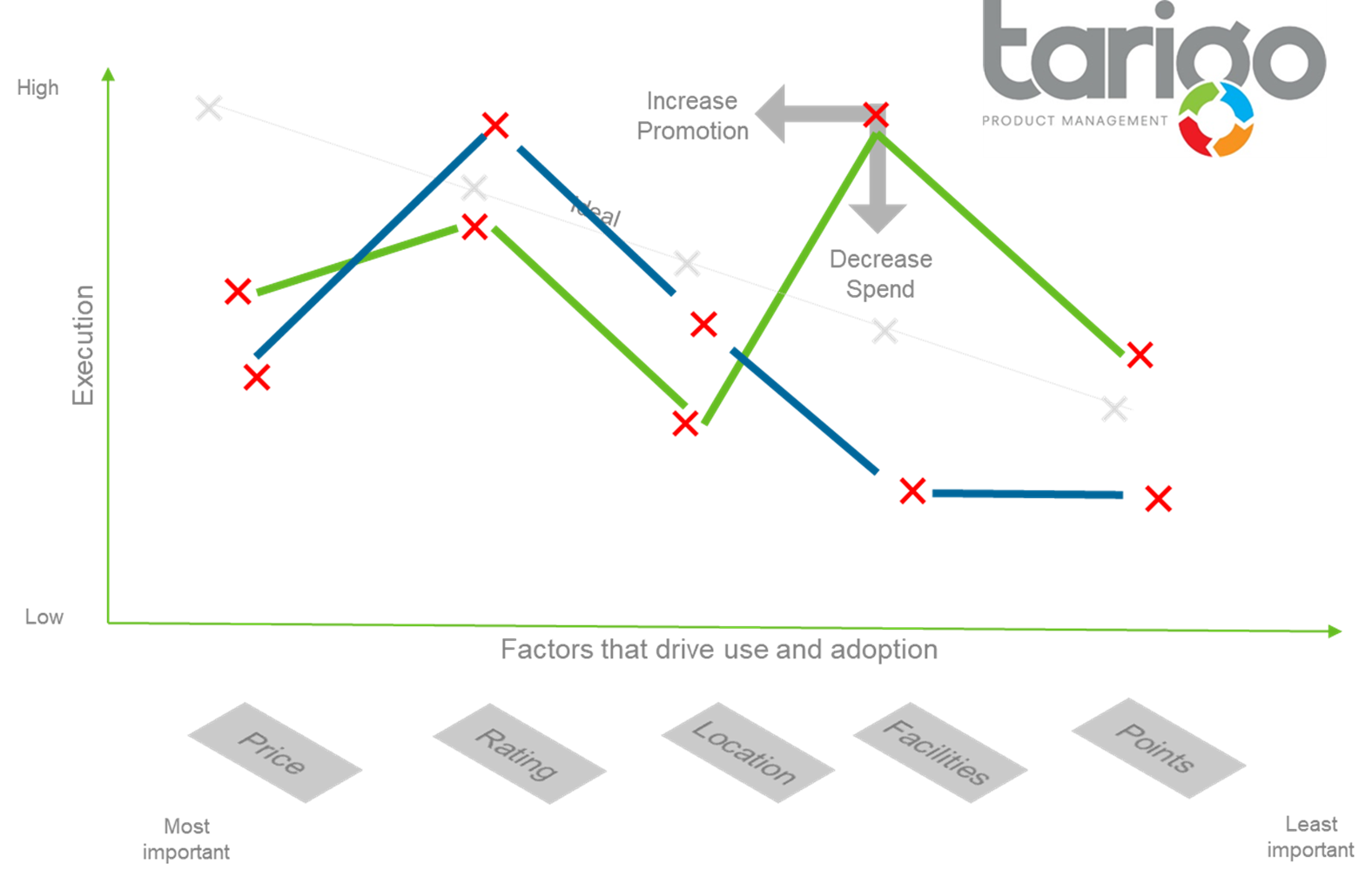
Competitive landscapes
Here’s a neat tool to help Product Managers assess their competitive landscape . Based on the fact that customers buy or use products for a set of reasons, it takes value proposition thinking and gives more depth and detail. Here’s how to use it:
1. Define a set of factors that drive use and adoption of your product or service. For example, what a guest books a hotel room they will consider price, but they’ll also think about location, facilities, rating, etc
2. Prioritise these factors from most to least important from the customer perspective
3. Plot your product in terms of execution – score high if you deliver really well on a factor, low is you execute poorly
4. Plot your competitors on the same graph
You can then think about action – where to invest or where to promote so that you optimise the value you deliver.
read more
Check out the Archive